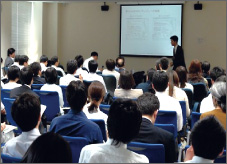● 1st
The Future of Academic Journals as a Means of Disseminating Research Results
The topic chosen to start the year was the key question, “Do academic journals have a future?” An overview was given by Prof. Syun Tutiya (Chiba University), followed by two specific talks by a mathematician and a physicist, Assistant Prof. Takao Namiki (Hokkaido University) and Prof Ken-ichi Ueda (The University of Electro-Communications). Prof. Tutiya discussed how the advent of electronic journals would change conventional print versions, as well as whether research result should be written in a paper and published in a journal. Assistant Prof. Namiki talked about the past, present, and future of papers in the basic sciences, including mathematics, and Prof. Ueda discussed the role of preprints, the diversification of peer review, and open access, among others.
● 2nd
Academic Publishing and XML Format: Issues in Japan
 Academic Publishing and the Approach to XML: Issues in Japan
Academic Publishing and the Approach to XML: Issues in Japan
Following on from the November 2007 seminar on XML publishing, we learned about e-journal publishing from the viewpoint of experts in XML production. The speakers were Mr. Haruhito Fukushige of Digital Communications, Co., Ltd., Mr. Tatsuzo Dazai of the Institute of Pure and Applied Physics (IPAP), and Mr. Kazuhiro Hayashi of Chemical Society of Japan. They covered topics in e-journal publishing, in particular how metadata are created.
● 3rd
The Status quo of the South Korean Consortium: Trying to expand Global Presence
Dr. Ho Nam Choi of the Korea Institute of Science and Technology Information (KISTI) was invited to speak about the South Korean consortium. Dr. Choi launched the first consortium of overseas e-resources at the Korean Advanced Institute of Science and Technology (KAIST), and he currently heads their integrated services team for domestic and overseas contents. This was a good opportunity to gain know-how on ways to improve the recognition of Japan’s e-journals with a view to increasing sales.
● 4th
Digitization of Annals and Surrounding Issues
A broad range of topics was addressed, as shown below, in a two-day session as a co-hosted event with Research Institute for Mathematical Sciences, Kyoto University.
(Honorific titles omitted.)
- “Recent Trends in Open Access”
Shinji Mine (Nagoya University Library Studies)
- “A Model of Amazon.co.jp’s Sales Ranks and an Analysis of the Long Tail”
Tetsuya Hattori(Graduate School of Science, Tohoku University)
- “Citation Statistics”
Tadao Oda (sProfessor Emeritus, Tohoku University)
- “SPARC Japan and Content Programs”
Koichi Ojiro (NII)
- “The State of Domestic Publication of Mathematical Journals”
Takao Namiki(Graduate School of Science, Hokkaido University)
- “Mathematical Formulae in the Digitization of the Journal of the Mathematical Society of Japan”
Nobuyuki Tose(Faculty of Economics, Keio University)
- “Toward the Practical Application of a Formula Search System”
Hideki Hashimoto (Graduate School of Engineering Science, Osaka University)
- “Digitization of Annals: A Case of Electronic Journals in Chemistry”
Kazuhiro Hayashi (Chemical Society of Japan)
● 5th
What Is the Most Appropriate OA Model for Japan?
A seminar on open access was held to mark the first worldwide Open Access Day (October 14, 2008). The speakers (titles omitted) and topics were as follows:
- “The Myths and the Truth about Open Access”
Yuko Nagai (Zoological Society of Japan)
-
“Four Years’ Experience with an Institutional Repository at a National University Library”
Kenichi Tomita
(Library Division, Research Promotion Department, Tokyo Institute of Technology)
- “Thoughts on Developing ‘My Open Archive,’ a Site for Uploading and Sharing Never-Before-Published Research Papers”
Keita Bando (My Open Archive)
- “Who Is Reading What? The Usage of Institutional Repositories, According to Access Logs”
Sho Sato (University of Tsukuba)
● 6th
Beyond IF: Different Perspectives on Research Evaluation
Impact factor (IF) has been the criterion for evaluating journals for over 40 years, but new efforts to explore other criteria have begun. We invited Mr. Martin Richardson of Oxford University Press (OUP) to speak on the Usage Factor Project started in 2007, and Mr. Jevin West of the University of Washington to talk about Eigenfactor scores. Prof. Masamitsu Negishi (NII) introduced a Japanese approach under the title “Bibliometric Indices for Evaluating Research and Periodicals: Present Status and Issues.”
● 7th
Open Access Update
This seminar was held at Pacifico Yokohama as part of the Library Fair & Forum. Mr. Martin Richardson of OUP, one of the first publishers in the world to experiment with open access, spoke about the diversification of open access models, taking “author-pays” as one example. And Mr. Kazuhiro Hayashi of the CSJ discussed moves toward open access in Japan, mainly in publishing by academic societies, and differences between Japan and the West in an attitude to OA.
● 8th
E-Journal Platforms Available in Japan
Based on a variety of past experiences with e-journals, Ms. Mikiko Tanifuji of the National Institute for Materials Science (NIMS) discussed what she looks for in scientific platforms as a producer, go-between, and user of them. Mr. Soichi Kubota of JST brought us up to date on J-STAGE and explained the future vision of its system. We also heard from Mr. Chris Beckett of Atypon Systems and Ms. Louise Tutton of Publishing Technology, who outlined overseas platforms that could be introduced in Japan in terms of function, cost, and other factors, given the greater affordability of journals to libraries and subscribers, thanks to the advent of electronic publishing that allows them to track user behavior.
● 9th
What We Have Done as Selected SPARC-Japan Journals
In a general review of SPARC Japan’s second term (2006–2008), the following speakers (titles omitted) reported on past activities and discussed future challenges and prospects: Masahiro Suyama (Japan Society of Mechanical Engineers), Noriko Nikaido (Institute of Electronics, Information and Communication Engineers), Hidenori Suzuki (Institute of Pure and Applied Physics), and Yuko Nagai (Zoological Society of Japan). A lively panel discussions followed, including comments from the floor. |

